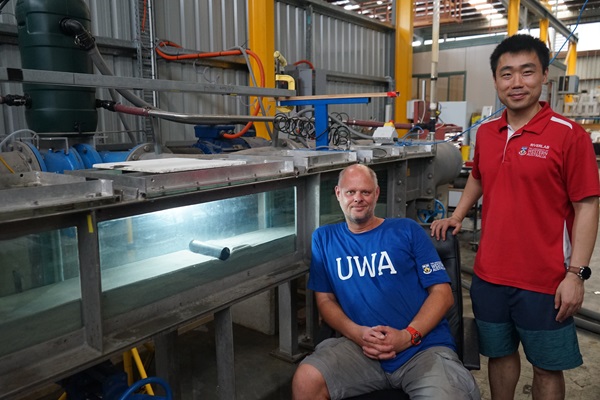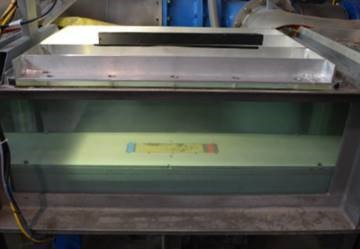
-
Highlights
-
Governance
-
Chancellor
-
Vice-Chancellor
-
Executive
-
History of the University
-
Schools
-
Campuses
-
Complaints
-
Official publications
-
Communications and marketing
-
Working at UWA
O-Tube
The large O-Tube, which is a closed-loop flume with a base of seabed soil. The cross-section of the flume is 1 m wide by 1 m tall, and the working section is 17 m long. The O-Tube motor is able to generate currents in excess of 3 m/s and wave velocities of up to 2.5 m/s (across periods of 5-15 s). The facility also includes a smaller O-Tube (approximately 5 times smaller in each dimension) which is used for complementary experiments.
Experiments in the O-Tubes provide observations of seabed behaviour during cyclones which could not otherwise be made, as well as fundamental insight into sediment transport and on the loading of infrastructure such as pipelines. For example, the O-Tube experiments allow direct measurement of the forces applied to a pipeline by cyclonic waves with up to 1 in 1000 year return periods. Meanwhile, the changing topography of the seabed is captured by digital imaging methods including binocular infra-red scanning.
Facility Specifications
- Overall length: 24.0m
- Overall breadth: 7.8m
- Height of test section: 1.4m
- Breadth of test section: 1m
- Length of test section: 17.6m
- Maximum steady currentvvelocity: 3m/s
- Peak oscillatory velocity at 5s period: 1m/s
- Peak oscillatory velocity at 13s period: 2.5m/s
- Regular, irregular oscillatory flow (combined with current)
- Sand bed: 0.8m deep, 1m wide and 14m long
- Two instrumented model pipelines (200mm and 50mm diameter) with load or displacement control
Previous Research Projects
- Developing better design guidance about role of field joints in initiating pipeline scour for trunklines
-
A key learning from applying the UWA-authored STABLEpipe design guideline on projects is that identifying and predicting scour initiation points along the pipeline are critical for kick-starting the scour process, leading ultimately to pipeline lowering and improved stability. For concrete coated trunklines, field joints present natural locations for the onset of scour given the locally reduced diameter.
Understanding and being able to predict the as-laid embedment condition and subsequent changes under ambient / non-extreme conditions is therefore of great interest.
This project is undertaking experiments to assess how field joints affect the changes in pipe embedment resulting from scour which occurs during ambient conditions; this understanding will then be used to assess the capacity of these joints to act as initiation points in subsequent storms.
Key Contact: Terry Griffiths
Email: [email protected]

- Erosion tests to measure threshold velocity
-
Sediment samples from Port Phillip Bay, Victoria were subjected to steady current velocity erosion testing and wave velocity erosion testing. The tests were conducted inside the small O-tube which, is capable of replicating steady state flow and rectilinear flow, similar to that experienced close to the bed under surface waves.
Applying incremental increases in flow velocity, we were able to determine their erosion resistance. Some phenomena such as cohesive bonding and mass erosion were observed.
Key contact: Scott Draper
Email: [email protected]

Current Projects
- Hydrodynamic load on underwater objects/vehicles and stability assessment
- Vortex Induced Vibration (VIV)
- Sediment transport under various flow conditions
- Local scour assessment around subsea structures
- Validation of scour protection
- Rock berm performance
- Assessment of marine growth on hydrodynamic loads and VIV


































